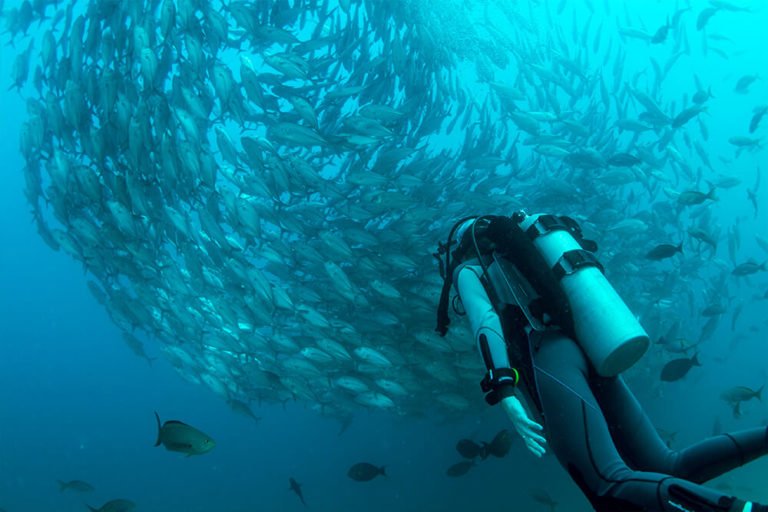Atmospheric Pressure and How it Affects Your Dive

From your first lesson as a diver, you’ll learn all about atmospheric pressure and how you can stay safe on deep dives. But since safety is always our first concern, let’s take it from the top.
AT SEA LEVEL
When you’re standing at sea level, you don’t feel any pressure. That’s because the air that surrounds us presses down on our bodies at 14.5 pounds per square inch—the same force that the fluids in your body are pressing outwards with.
DIVING DEEPER
After you dive down even a few feet, you’ll start to feel the pressure increase (likely on your eardrums). This is due to a hydrostatic pressure, which is the force per unit area exerted by a liquid on an object. So the deeper you dive, the greater the pressure—literally and figuratively speaking. For every 33 feet you descend, the pressure will increase by 14.5 psi.
SPECIES SPOTLIGHT
As you may have guessed, the atmospheric pressure doesn’t affect many sea creatures. Whales, in particular, can withstand dramatic pressure changes. (They hunt for squid at depths of 7,000 feet or more.) Whales’ ribs are bound by bendable cartilage, which allows the rib cage to collapse at pressures that could easily snap our bones. The same goes for their lungs, which are also collapsable, keeping them from rupturing.

PRESSURE ON THE PLUNGE
Unlike whales, the human body cannot withstand these pressure changes. So we need to take extra safety measures to ensure a smooth (injury-free) dive.
EQUALIZATION
The rapid changes in pressure as you descend on your dive can lead pain and injury—particularly in hollow spaces, LIKE THE EARS, masks, and lungs. On the ascent, the reverse happens. Decreasing pressure can cause air to expand, which can cause ears and lungs to become overfull of air.
To avoid injuries and pain, you must equalize the pressure. You can do this by breathing normally on both the descent and ascent. On the descent, you can also add air to your mask by breathing out of your nose.
BUOYANCY
Divers control their BUOYANCY by adjusting their lung volume and buoyancy control device (BCD). As a diver descends, the increased pressure causes the air in their BCD and wetsuit to compress, making them negatively buoyant (AKA sink). As they sink, the air in the dive gear compresses more and they sink more quickly. Divers must add air to their BCD in order to compensate for their negative buoyancy—or else they could be on an uncontrolled descent.
The opposite is true for the ascent. As they float towards the top, the ambient pressure decreases and the air in their dive gear expands. So the diver must vent air continuously from their BCD to avoid an uncontrolled and rapid ascent.
BOTTOM TIME
Bottom time refers to how long a diver can stay underwater before beginning their ascent. If a diver inhales rapidly, their bottom time will be reduced. Plus, the greater the pressure, the more a diver’s body will absorb nitrogen. A diver can only allow a certain amount of nitrogen absorption before beginning their ascent or else they could run the risk of decompression illness. Because the pressure becomes greater with depth, both air consumption and nitrogen absorption increases the deeper the diver goes.
